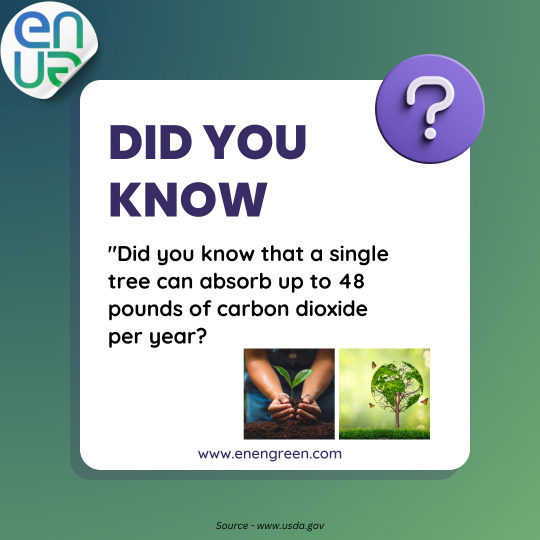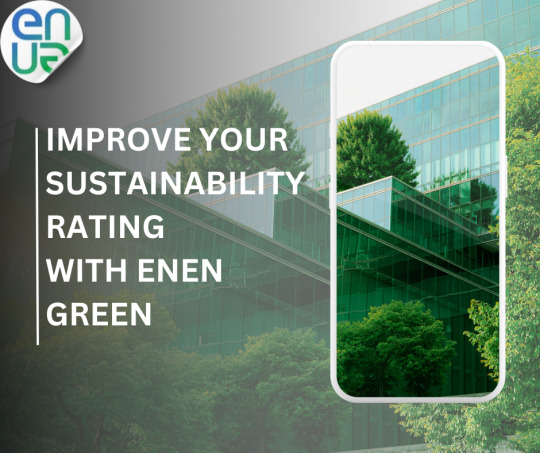Don't wanna be here? Send us removal request.
Text

Scop 3 Emission Update | Enen Green
Scope 3 emissions, which arise from a company’s supply chain activities, can account for over 90% of its total greenhouse gas footprint.
Investing in sustainable products, and decarbonization practices can make a significant impact.
0 notes
Text

Green Facts By Enen Green
1 note
·
View note
Text

Tip Of The Day....
By - https://www.enengreen.com/
0 notes
Text

Did You Know? About This In Sustainability
0 notes
Text

The Path to Carbon Neutrality: Strategies and Best Practices
As the global urgency for addressing climate change intensifies, businesses are increasingly seeking ways to achieve carbon neutrality and contribute to a more sustainable future. EneGreen, a leading consultancy firm specializing in sustainability and carbon management, has been at the forefront of this movement, offering innovative strategies and best practices to help companies on their journey to carbon neutrality. This article explores the key strategies and best practices shared by EneGreen to guide businesses towards a greener and more sustainable future.
Understanding Carbon Neutrality
Carbon neutrality refers to achieving a balance between emitting carbon and absorbing carbon from the atmosphere in carbon sinks. It involves reducing greenhouse gas (GHG) emissions as much as possible and compensating for the remaining unavoidable emissions through carbon offset projects. EneGreen emphasizes that the path to carbon neutrality is not just about offsetting emissions but also about fundamentally transforming business operations to minimize their carbon footprint.
Key Strategies for Achieving Carbon Neutrality
Comprehensive Carbon Footprint Assessment EneGreen starts by conducting a thorough assessment of a company’s carbon footprint. This involves measuring and analyzing GHG emissions across all operations, including direct emissions (Scope 1), indirect emissions from purchased electricity (Scope 2), and other indirect emissions along the value chain (Scope 3). Accurate measurement is crucial for identifying the most significant sources of emissions and setting a baseline for improvement.
Setting Science-Based Targets Once the carbon footprint is assessed, EneGreen helps companies set science-based targets (SBTs) aligned with the Paris Agreement’s goal of limiting global warming to well below 2°C above pre-industrial levels. These targets provide a clear and measurable pathway for reducing emissions and ensuring that the company’s climate actions are grounded in scientific reality.
Implementing Energy Efficiency Measures Energy efficiency is one of the most cost-effective ways to reduce carbon emissions. EneGreen works with companies to identify energy-saving opportunities, such as upgrading to energy-efficient lighting and equipment, optimizing HVAC systems, and improving industrial processes. These measures not only reduce emissions but also result in significant cost savings.
Transitioning to Renewable Energy EneGreen advocates for transitioning to renewable energy sources as a critical step towards carbon neutrality. This includes investing in on-site renewable energy installations, such as solar panels or wind turbines, and purchasing green energy from certified renewable energy providers. By shifting to renewable energy, companies can significantly reduce their reliance on fossil fuels and lower their carbon footprint.
Sustainable Supply Chain Management Emissions from the supply chain often constitute a significant portion of a company’s overall carbon footprint. EneGreen assists companies in engaging with suppliers to promote sustainable practices, such as reducing emissions from transportation, sourcing sustainable raw materials, and adopting circular economy principles. Building a sustainable supply chain is essential for achieving comprehensive carbon neutrality.
Carbon Offsetting and Sequestration After maximizing emission reductions, some residual emissions may still remain. EneGreen guides companies in investing in high-quality carbon offset projects, such as reforestation, afforestation, and renewable energy projects in developing countries. These projects help to sequester carbon and compensate for unavoidable emissions, moving companies closer to carbon neutrality.
Best Practices for Sustaining Carbon Neutrality
Continuous Monitoring and Reporting Maintaining carbon neutrality requires ongoing monitoring and transparent reporting of emissions and progress towards targets. EneGreen recommends implementing robust monitoring systems and leveraging digital tools for real-time tracking of emissions. Regular reporting not only ensures accountability but also helps identify areas for further improvement.
Employee Engagement and Training Engaging employees in sustainability initiatives is crucial for driving change. EneGreen advises companies to conduct regular training sessions and workshops to educate employees about the importance of carbon neutrality and how they can contribute. Creating a culture of sustainability within the organization fosters collective action and innovation.
Stakeholder Collaboration Collaboration with stakeholders, including customers, investors, and regulatory bodies, is essential for achieving long-term sustainability goals. EneGreen encourages companies to communicate their carbon neutrality commitments and progress transparently, fostering trust and support from stakeholders. Collaborative efforts can lead to shared resources and knowledge, accelerating the journey towards carbon neutrality.
Adopting Innovative Technologies Technological advancements play a pivotal role in reducing carbon emissions. EneGreen highlights the importance of staying abreast of emerging technologies, such as carbon capture and storage (CCS), hydrogen energy, and smart grid solutions. Investing in innovative technologies can provide new avenues for emission reductions and enhance overall sustainability.
0 notes
Text

How Carbon Offsetting Works: A Guide by EnenGreen
EnenGreen offers a thorough, user-friendly synopsis of the carbon offsetting procedure. It guides readers through the process of calculating their carbon footprint, cutting back on emissions, and selecting reliable carbon offset initiatives. People and organizations can efficiently offset their environmental impact by buying carbon credits and supporting programs like reforestation and renewable energy. In order to enable readers to contribute to a sustainable future and attain carbon neutrality, this book places a strong emphasis on the significance of verified initiatives and transparent reporting.
Enengreen: Trusted EcoVadis Service Partner for Sustainable Business Solutions
0 notes
Text

Enhance Sustainability Ratings: Key Practices for Success
1. Implementing Comprehensive Environmental Management Systems.
~ Regular Audits and Assessments
~ Setting Measurable Goals
~ Continuous Improvement
2. Reducing Carbon Footprint
~ Adopt Renewable Energy
~ Enhance Energy Efficiency
~ Offset Emissions
3. Sustainable Supply Chain Management
~ Supplier Audits
~ Ethical Sourcing
~ Transparency
4. Waste Reduction and Recycling
~ Implement Zero-Waste Policies
~ Reduce Single-Use Plastics
~ Promote Circular Economy
5. Employee Engagement and Training
~ Sustainability Training
~ Incentive Programs
~ Green Teams
6. Corporate Social Responsibility (CSR) Initiatives
~ Community Engagement
~ Diversity and Inclusion
~ Ethical Governance
7. Sustainable Product Design
~ Eco-Friendly Materials
~ Energy-Efficient Products
~ Longevity and Durability
8. Sustainability Reporting and Communication
~ Regular Reporting
~ Stakeholder Engagement
~ Clear Communication
In order to raise their EcoVadis rating, EnenGreen train firms are dedicated to strengthening their sustainability initiatives. Their main objectives include lowering carbon emissions, making use of renewable energy sources, and advancing environmentally friendly technologies. Enengreen strives to achieve strict sustainability criteria through sustainable practices and strict environmental management systems, guaranteeing a positive environmental impact and an improved rating from EcoVadis.
Enquiry Now EnenGreen
0 notes
Text

EnenGreen - Ecovadis Service Partner | Sustinability | Carbon Footprint | ESG | Carbon Credit
In a world where sustainability is becoming more and more significant, lowering carbon footprints and obtaining sustainability certifications are essential for both individuals and organizations. One major competitor in this market is EnenGreen, which offers comprehensive services that help reduce carbon emissions and facilitate the acquisition of carbon credits and sustainability certificates. EnenGreen achieves these goals in this way. EnenGreen provides a thorough analysis of carbon emissions across project borders in accordance with the guidelines provided by ISO 14064 and the Greenhouse Gas (GHG) Protocol. This methodical approach ensures accurate and reliable carbon footprint assessments. In this sector, EnenGreen is the fastest and best service supplier. To obtain an EcoVadis sustainability rating, you simply ask them a question.
4 notes
·
View notes